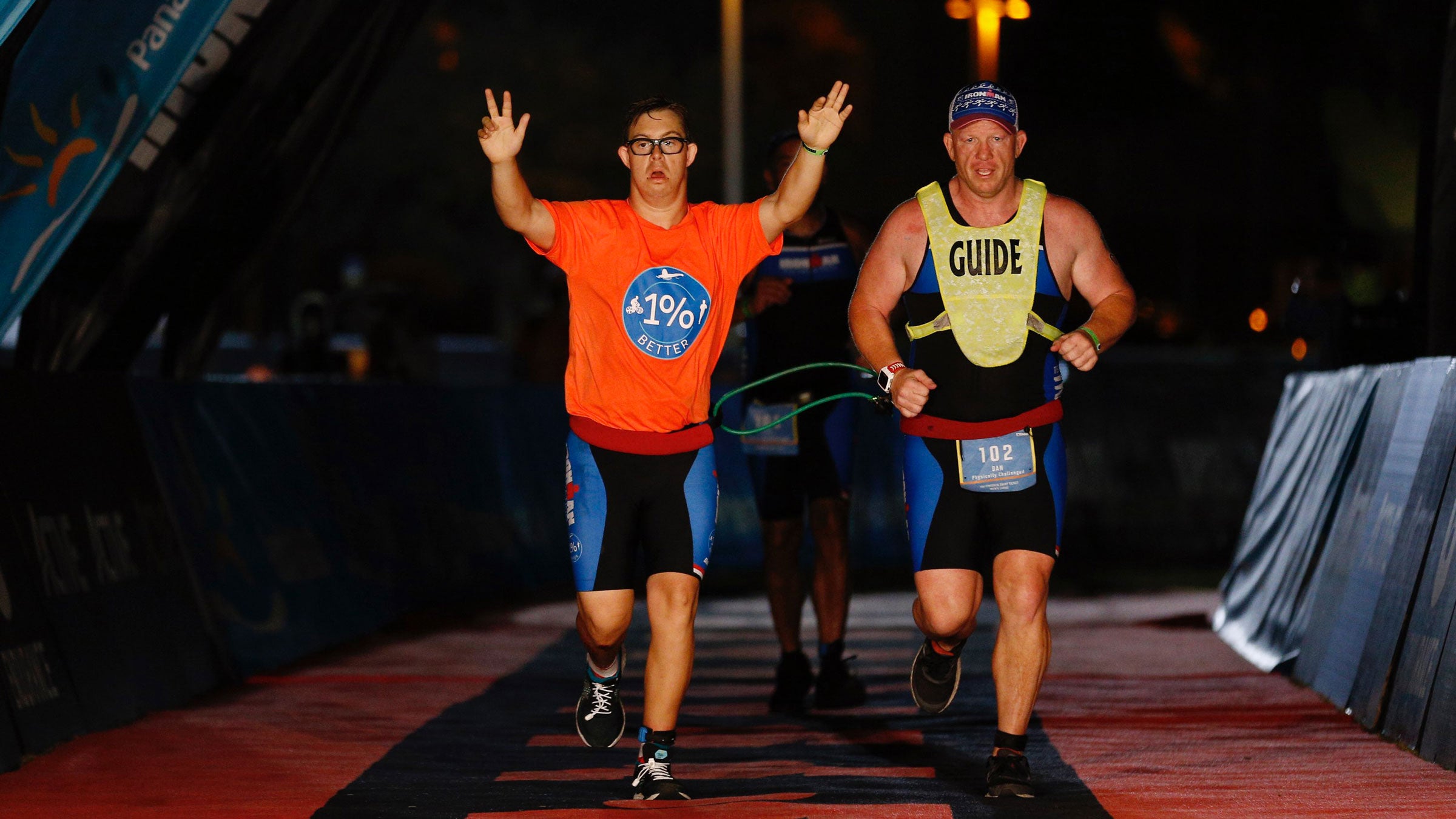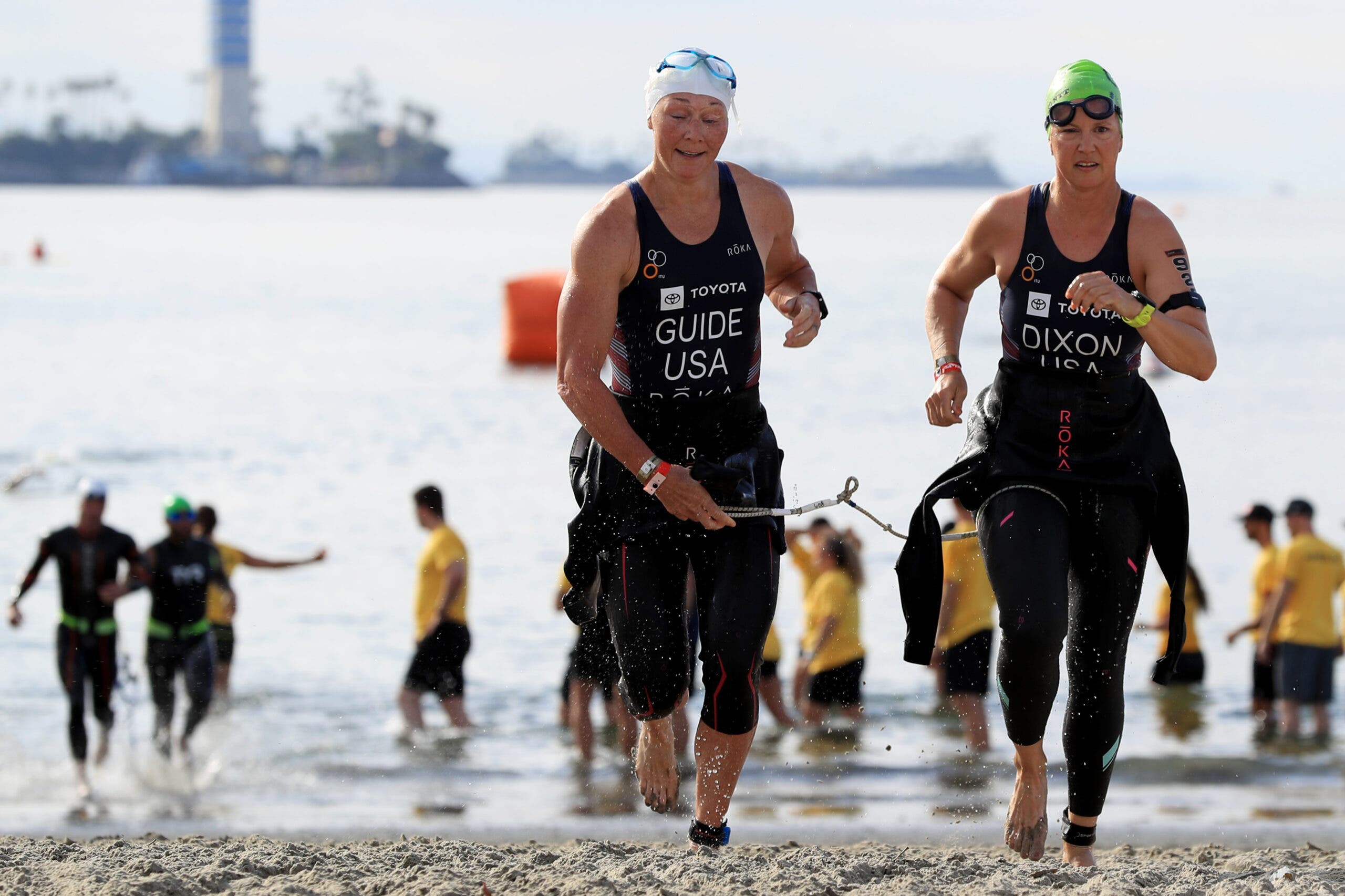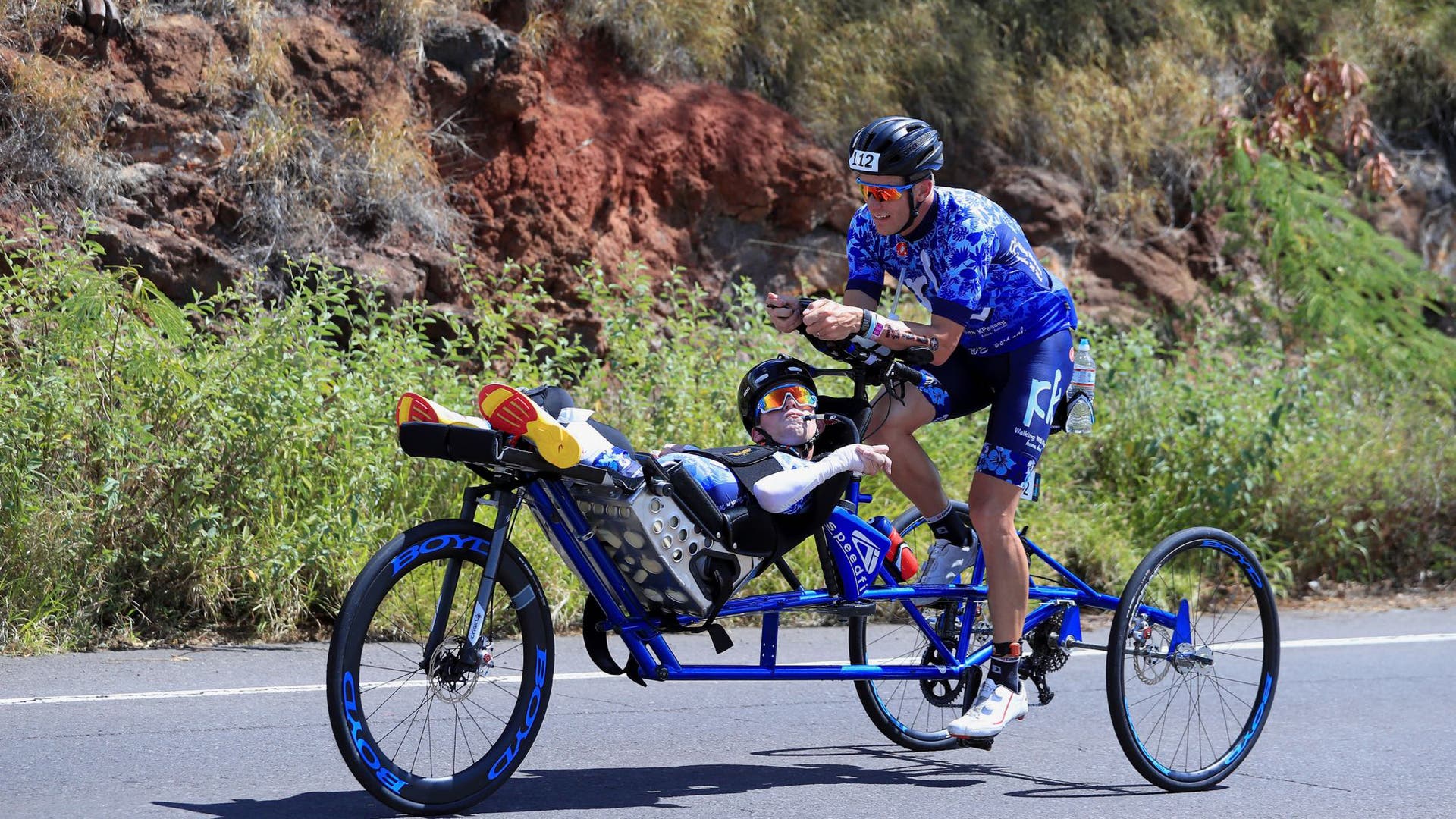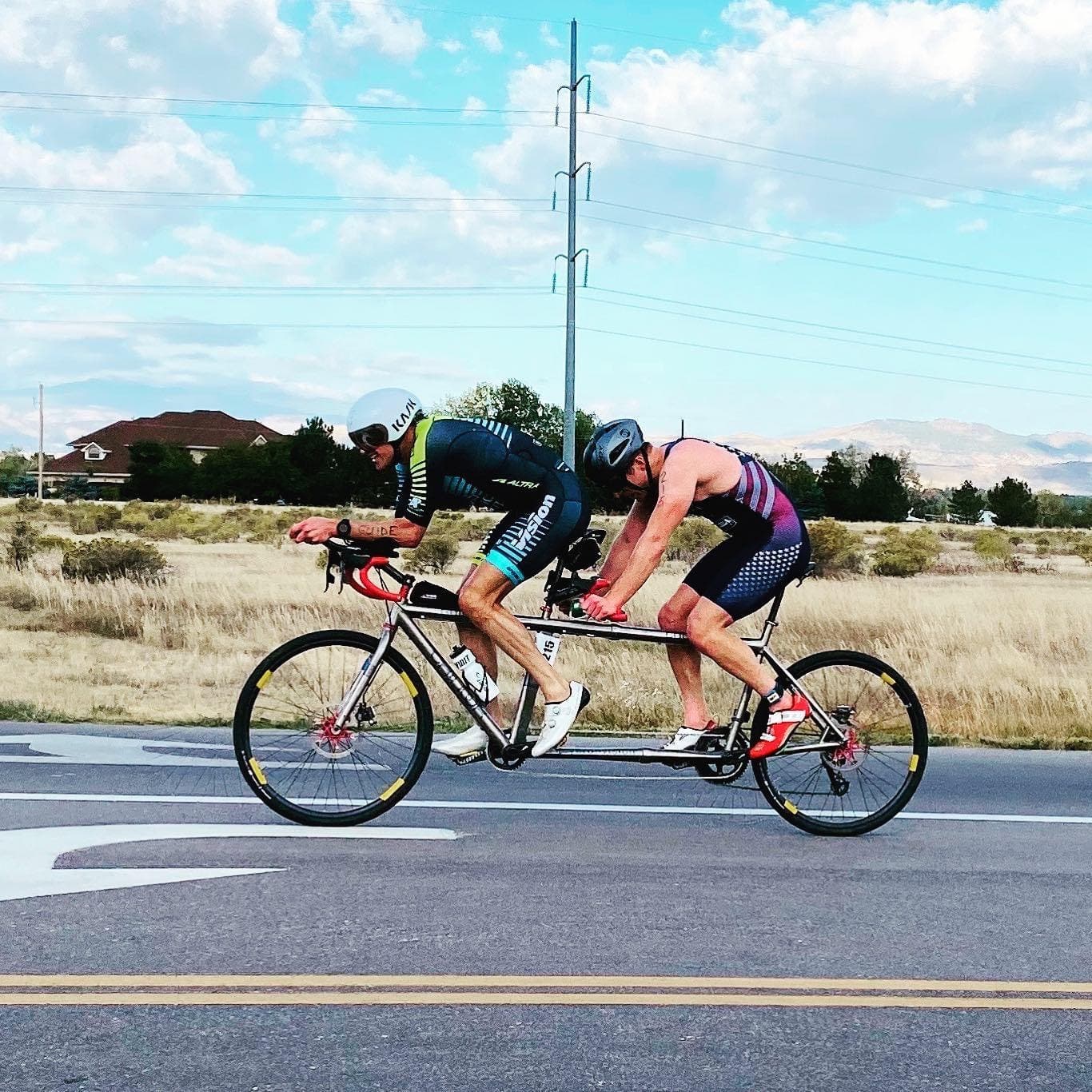How to Become a Guide for Athletes with Disabilities

(Photo: Michael Reaves/Getty Images)
If you’ve ever watched a paratriathlon, you’ve likely seen some athletes racing with a second person, often tethered to the athlete. This is the athlete’s guide, a critical piece of equipment for athletes with disabilities, acting as their eyes, navigator, or safety support.
Guides rightfully play a backseat role to the athletes they support. Even with a guide, an athlete is still racing hard and does not gain an advantage over other athletes because of their guide. Guides simply help an athlete with a disability to train and race to their full potential.
Guides aren’t only for elite paratriathletes. Many age-group triathletes with disabilities rely on guides as well. Because there is such a wide variety in the speeds and skill sets of athletes with disabilities, there’s a need for a wide variety of guides—which is why many people serve as guides, from Olympians Michelie Jones, Andy Potts, and Greg Billington supporting Paralympic triathletes to hundreds of everyday age-group athletes looking to finish their first race.
Being a guide is a great way to share a love of multisport with other triathletes. The best part? You don’t need a special skill set to become a guide. All you need is confidence, compassion, communication, and a willingness to try.

RELATED: What is Paratriathlon?
Types of Triathlon Guides
What often comes to mind with the word “guide” is that the athlete is blind or has a physical disability that requires the use of a wheelchair. While those two scenarios do allow for an athlete to race with a guide, they aren’t the only reasons an athlete might have one. There are many reasons an athlete may qualify to have a guide with them when they race.
Dan Grieb is a six-time Ironman finisher who has built his life around sport and service. In 2020, Grieb guided athlete Chris Nikic for all of Ironman Florida. Nikic became the first person with Down syndrome to complete an Ironman when he crossed the finish line in Panama City Beach.
“There is no manual for working with an athlete with a disability,” said Grieb. “You have to figure it out as you go—and that’s OK.”
As an athlete with Down syndrome, Nikic processes things like pain and time differently. His reaction times are slower, balance is a bit harder, and new locations can be challenging.
Grieb is there to make sure that Nikic completes his training and racing safely, helping him to face the highs and lows of the day with a supportive, rational voice every step of the way. This means that Grieb and Nikic are tethered together during the swim portion of a tri, ride separate bikes but stay in close proximity for the bike portion, and run with a bungee-like tether between them on the run.
Their athlete-guide relationship is just one of many different kinds of guides one might see in triathlon. A triathlete who is blind, for example, may use a guide for assistance with route and course directions, information about the terrain, and other critical guidance such as when to mount and dismount a bike.
Triathletes who use a wheelchair or have a physical disability that limits solo swim, bike, and run abilities may also use a guide to help in the physical progression of the athlete throughout a race. This might mean the guide pushes the athlete in a wheelchair during a run, bikes with them in some sort of bike-and-seated compartment combination (like Kyle and Brent Pease), and/or tethers themselves to an inflatable boat with the athlete seated in it during the swim.

Who can become a guide for athletes with disabilities?
The short answer: anyone! Any age-group athlete who is confident in their swim, bike, and run skills and is willing to learn and smile through failure and mishaps is able to serve as a guide.
Mary Shepro is a Chicago-based triathlete and became linked up with Ashley Eisenmenger through Dare2Tri, a Chicago-based nonprofit that connects athletes with a disability to local guides. Shepro serves as Eisenmenger’s guide. Eisenmenger is blind and is an elite paratriathlete who has trained numerous guides, as well.
Shepro, a lifetime swimmer, got started in triathlon after college as a way to maintain her fitness. After completing her first triathlon at the Chicago Triathlon in 2016, Shepro became connected with Dare2Tri through the local tri scene. She first met Eisenmenger at a neighborhood run meetup in 2020 and the pair instantly clicked.
When Eisenmenger’s usual guide became injured, Shepro was ready to step up to the plate, leveraging her background in swimming to match Eisenmenger’s speed in the pool. Since then, the pair have completed numerous races together and are working on planning their 2022 race schedule.
“Although most people come from a good place when they say they want to guide, many do not realize the time commitment it takes to be one,” said Keri Serota, co-founder of Dare2Tri. “And yes, it is a really fulfilling thing, to be able to guide someone, but you have to be willing to put in the time and energy to be a good guide.”
RELATED: How to Make Triathlon More Accessible for Athletes with Disabilities
Get into guiding for the right reasons
Before you dive headfirst into becoming a guide, consider your motivation for wanting to become one. While it’s true that some paratriathletes would not be able to complete a race without a guide, it’s important to remember that paratriathletes are not “helpless” or “weak” without one. It’s important to note that if you become a guide, it’s not about you—it’s entirely about the athlete.
“Guiding an athlete should go way beyond the motivation of ‘This is going to make me feel good,’” Serota said. “Guiding should have nothing to do with you, per se. Instead, it should be you saying ‘I’m going to put my goals aside and focus on helping someone else reach theirs.’”
And this doesn’t just mean assisting someone in reaching a new PR. Serota noted that as a guide, you need to cater to the athlete. If the athlete likes to show up right when transition opens, you need to show up then, too. If the athlete likes to do only local races and no big-name races, then you need to find joy in the local races, too.
RELATED: Can You Bring a Service Dog to a Triathlon?

Training guides for athletes with disabilities
“I’ve had friends before text me and say, ‘Hey, I can’t make it to your run—but I’m sending a roommate, it’ll be OK!’” Eisenmenger laughed. “Luckily, running is the easiest of the three sports to train as long as the guide is willing to be communicative and learn; I’ve done my fair share of training guides on a whim.”
Most of the time, however, athlete guides are not a last-minute relationship, but one built over time and through training. There is currently no formal USA Triathlon (USAT) guide certification or course; instead, many guides get their training through organizations like Dare2Tri, Challenged Athletes Foundation, or even the Special Olympics. In clinics offered by these groups, guides learn the skills needed to successfully support their athletes in training and racing. This may sound complicated, but it’s usually not—for example, those with good bike-handling skills find it’s a fairly easy learning curve to get the hang of riding a tandem bike. It simply takes some practice.
What comes less naturally to some is establishing an effective line of communication between athlete and guide.
“It can be hard to convey to the athlete how far away a puddle or hole is,” Shepro said. “For example, if I say, ‘Puddle!’ right when I’m about to step in a puddle, then that means the athlete won’t step in the same spot for another second or two. So, it takes practice to get the communication and timing right.”
Grieb was also unsure at first how to best guide Nikic. Thankfully, Nikic’s father, Nik, was a patient teacher. “At the beginning of working with [Chris Nikic], I had no comfort. If I waited to feel comfortable, I never would have become a guide,” Grieb said. “When we first started working together, I was worried I would somehow hurt Chris, I was worried I would say the wrong thing, I was worried about a lot.”
Nik Nikic was a steadfast teacher for Grieb, advising Grieb how to best communicate with Chris, how to see the world as Chris sees the world, and how to push Chris physically without going into a dangerous zone—but it took time, another consideration for those looking to work with an athlete with a disability.
How do I become a guide?
Every path to guiding is different. Some become guides for friends and family members, while others seek out opportunities with local organizations serving athletes with disabilities. Grieb linked up with Nikic after learning that Chris was becoming too fast for his assigned guide from the Special Olympics.
Grieb regularly trained with him before dawn, on the weekends, and in between work and life obligations so that the two could be prepared to race Ironman Florida in 2020. Together, the pair finished their 140.6-mile journey just before the 17-hour cutoff. The relationship continues today. Currently, they’re gearing up to race at the Ironman World Championship this year, with Grieb serving as Chris’ guide.